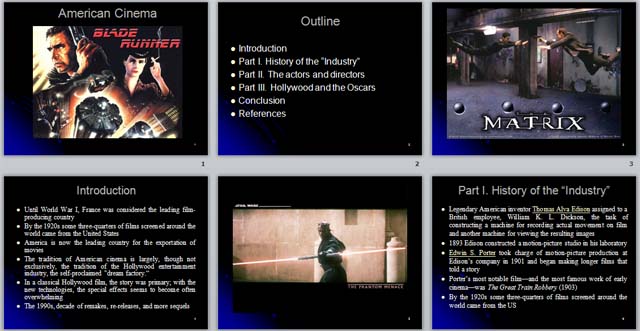Introduction
Until World War I, France was considered the leading film-producing country
By the 1920s some three-quarters of films screened around the world came from the United States
America is now the leading country for the exportation of movies
The tradition of American cinema is largely, though not exclusively, the tradition of the Hollywood entertainment industry, the self-proclaimed "dream factory. “
In a classical Hollywood film, the story was primary; with the new technologies, the special effects seems to become often overwhelming
The 1990s, decade of remakes, re-releases, and more sequels
Part I. History of the “Industry”
Legendary American inventor Thomas Alva Edison assigned to a British employee, William K. L. Dickson, the task of constructing a machine for recording actual movement on film and another machine for viewing the resulting images
1893 Edison constructed a motion-picture studio in his laboratory
Edwin S. Porter took charge of motion-picture production at Edison’s company in 1901 and began making longer films that told a story
Porter’s most notable film—and the most famous work of early cinema—was The Great Train Robbery (1903)
By the 1920s some three-quarters of films screened around the world came from the US

In the 1920s Chaplin began making feature-length comedies, including The Kid (1921) and The Gold Rush (1925)
Advent of recorded sound in the 1920s changed motion pictures
First demonstrated in 1926, recorded sound was in almost universal use by 1930
Two new genres that flourished with the coming of sound were gangster films and musicals (Fred Astaire, Ginger Rogers)
Film animation gained in popularity; Walt Disney first animated cartoon with synchronized sound, Steamboat Willie (1928), featured Mickey Mouse
Snow White and the Seven Dwarfs (1937), feature-length animated films
In 1941 Orson Welles made Citizen Kane
Color was used in only a minority of films until the 1950s; color movies had become the standard by the 1960s
The advent of television caused a great disruption
Increasing emphasis on the importance of the director in the 1960s (Stanley Kubrick, Robert Altman)
In the early 1970s a younger generation of filmmakers (Woody Allen, Francis Ford Coppola, George Lucas, Martin Scorsese, and Steven Spielberg)
Jaws marked the turning point in the fortunes of the American film industry, rewriting the blockbuster formula (first film to earn more than $100 million for its studio)
Полную информацию смотрите в файле.

 Получите свидетельство
Получите свидетельство Вход
Вход

































 Американское кино (презентация) (0.98 MB)
Американское кино (презентация) (0.98 MB)
 0
0 1274
1274 145
145 Нравится
0
Нравится
0



